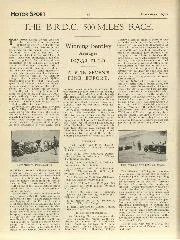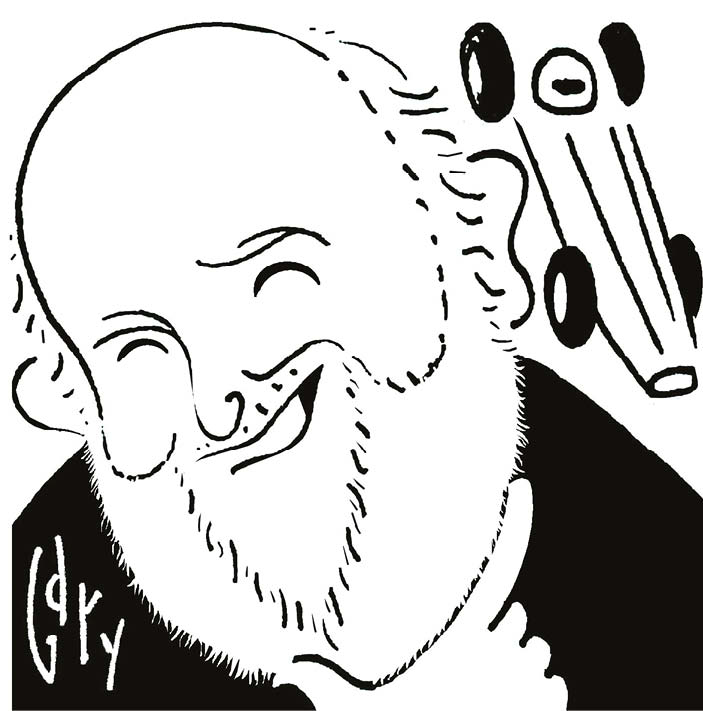
MOTOR SPORT THE B,R.D.C. 500 - MILES RACE
THK B.R.D.C. 500-MILES RACE. THE British Racing Drivers Club are to be congratulated on the success of their first event. Not only was it the first really long distance purely…

So, how was this past Formula 1 season for you? Having asked a pretty wide cross-section of variably committed fans of varying ages, the consensus appears to be along the lines of “A curate’s egg – good in parts”. Can any major sport involving so many qualifying rounds expect to be anything better? Probably not…
But I do have something of a bee in my bonnet about how the reluctance of some drivers to accept supporting status within a team seems to be so uncritically accepted these days. Your first rival is your team-mate? Maybe so, but historically that’s just facile modern motivational claptrap.
When Grand Prix teams ran more than just two entries a pecking order amongst ‘the staff’ was more readily discernible. It was certainly much more widely regarded as the norm. While the lesser driver in such two-car 1970s teams as Ferrari – or McLaren for that matter – would be widely assumed to be ‘just’ a number two, whatever Clay Regazzoni or Jochen Mass might have felt privately about that role, they largely kept any dissatisfaction to themselves, or within the team and did not share it loudly with press and public.
In doing so they followed in the long tradition of, say, Moss in his Mercedes season of ’55 – when in the open-wheelers at least team leader Fangio was very much ‘The Boss’ – or Trevor Taylor at Team Lotus 1962-63 when Jimmy Clark first spread his wings. Number two drivers, whether on their way up, or down – just didn’t whinge about it.
The same could hardly be said in reference to more recent team duos, such as Sebastian Vettel and Mark Webber at Red Bull 2009-13 – or certainly of Lewis Hamilton and Nico Rosberg at Mercedes 2013-16. An off-putting amount of dirty washing seemed too often to be laundered in public. Most of this hand-bags malarkey seemed depressingly unnecessary. C’mon guys! You are meant to be hero figures – superb athletes – immensely courageous, capable and composed young gods… not playground squabblers.
After such thoughts emerge, I’ll polish my rose-tinted specs. Come on you daft old codger – get real, this is a hugely pressured, super-sophisticated, big-money modern sport. Their trainers keep all these young lions in reinforced cages, feed them raw humus… and encourage cannibalism.
Back in the early 2000s I compiled a book based upon the private letters exchanged between our greatest British racing driver of the ’tween-war years – Dick Seaman – and his photographer friend, George Monkhouse. Dick was a works Mercedes-Benz driver 1937-39 – a rising star who won the 1938 German GP on the company’s home soil, only to crash fatally while leading the 1939 Belgian GP.
“No racing driver has ever been bigger than their paymaster”
After that year’s early-season EifelRennen at the Nürburgring, when Mercedes’ former engine mechanic-turned-new star driver Hermann Lang had won and the team’s old number one Rudi Caracciola could only finish third, Dick wrote to George in England describing how post-race: “Rudi did a terrific sulk, saying (a) Lang was given the fastest car (quite forgetting he himself had declined the offer of driving it). (b) His engine was cold at the start. (c) The mechanics bungled his pit stop […in fact he overshot the mark…]. He was assisted by [the similarly ageing number two] Manfred [von Brauchitsch], who I must say has been behaving extremely childishly all year… Their wrath is of course directed against poor Lang, with whom they are now starting to include me, apparently for the sole reason that we are younger and have our own success…”
On June 14, 1939, Dick wrote a follow-up letter to George, telling him more about Caracciola and Brauchitsch: “Apparently after the EifelRennen they created an even bigger stink than I realised, Caracciola even resigning. He then calmed down and confined himself to a colossal whine… Apparently he objects to being no longer considered the best and only driver in the team, but his allegations about Lang being favoured were entirely disproved in investigation. I, on the other hand, having learnt to speak German a lot better, now get on extremely well with Lang. Quite apart from his driving, he is a very good fellow and not a sulky child like the others…”
Caracciola had actually written to Dr Kissel (Daimler-Benz CEO) on May 27 that year, right after the EifelRennen, whingeing that the works team: “has an obsession with Lang. Herr Neubauer admitted to Herr von Brauchitsch that he was standing by the man on whom the sun shines… I want to go on driving. However, this presupposes that I fight with the same weapons. Yet this will hardly be possible, as almost all the mechanics are on Lang’s side, because he is [also] from Württemberg [so] …I have to tell you that I am placing my post at your disposal. I have always represented the Mercedes star with the greatest commitment… With Heil Hitler and best wishes, Rudolf Caracciola…”.
When Dick Seaman next encountered “Caracciola mit Frau…” at a company lunch to celebrate their team’s Tripoli GP victory, he said the couple were “both very polite and small, having been told exactly where they ‘got off’ by Dr Kissel…”
No racing driver – throughout motor racing history – has ever been bigger, when it came to the ultimate push and shove, than their paymaster…
Doug Nye is the UK’s leading motor racing historian and has been writing authoritatively about the sport since the 1960s